By Audwin Cash

 If your solar system is larger than you need, you are overpaying, which will dramatically increase your payback period and limit the cost-effectiveness of the system. You do not want this to be your situation so check with the manufacturer of the solar lighting systems. Experts and programs make sizing simple and easy for lighting applications. If your solar system is larger than you need, you are overpaying, which will dramatically increase your payback period and limit the cost-effectiveness of the system. You do not want this to be your situation so check with the manufacturer of the solar lighting systems. Experts and programs make sizing simple and easy for lighting applications.
If your system is too small, it will not perform adequately. This is the case when purchasing a lighting system online with basic information and no technical support. Use caution when purchasing directly from online suppliers with one system fits all. Systems based on cheapest prices are the systems that are not properly sized for the multitude of locations. These systems will lead to disappointment and not make an impact on your bills to properly pay for itself.
A reputable company will offer, a complete sizing evaluation, perfectly designed to help you choose the right solar lighting system. They can size a system according to your specific needs and budget more easily.
When inquiring about properly sizing your system you should be asked:
-Where is the project?
-What are the light level goals?
-What operating modes are acceptable?
-Is this a LEED project?
The devil is in the details.
Sizing for Solar Outdoor Lighting
There are several crucial inputs to help you determine the proper sizing for outdoor lighting and they are:
-Geography
-Operating Mode
-Number of nights autonomy1)
-Power draw of light
-Lighting Supplier/Manufacture Experience
Geography
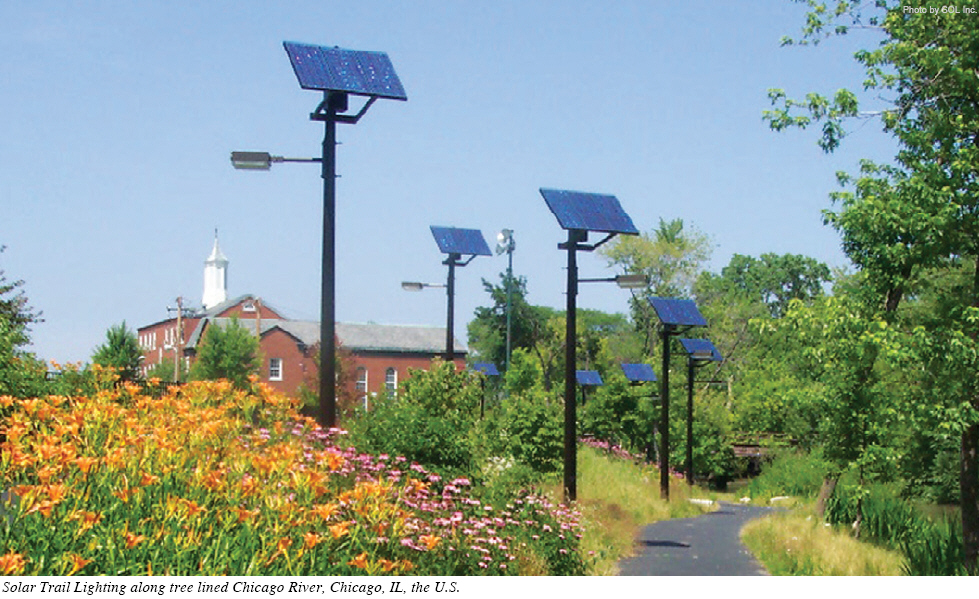
In sizing an outdoor lighting system using solar power, the first two factors we consider are the sunlight levels (insolation values) from your area and the daily power consumption of your lighting loads. Orientation of a solar array is best at true south. The more an array is situated off of true south, the less the total insolation value. Insolation or sunlight intensity is measured in equivalent full sun hours. One hour of maximum or 100% sunshine received by a solar panel equals one equivalent full sun hour. Even though the sun may be above the horizon for 14 hours a day, this may only result in six hours of equivalent full sun.
There are two main reasons. One is reflection due to a high angle of the sun in relationship to your solar array. The second is also due to the high angle and the amount of the earths atmosphere the light is passing through. When the sun is straight overhead, the light is passing through the least amount of atmosphere.
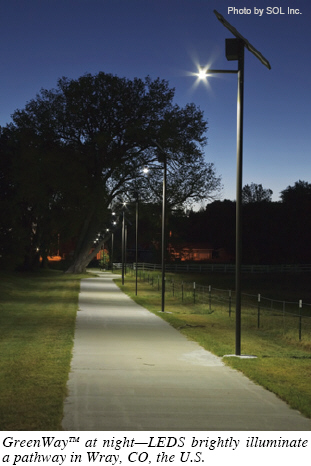 When sizing solar panels and battery packages for a solar lighting system, take these equivalent full sun hour figures per day and determine the worst case scenario. A proper lighting system is calculated based on the worst case to set your panel and battery size. Using an average sun hours calculation, that many companies use, provides the system that will be just average and under perform for the application. When sizing solar panels and battery packages for a solar lighting system, take these equivalent full sun hour figures per day and determine the worst case scenario. A proper lighting system is calculated based on the worst case to set your panel and battery size. Using an average sun hours calculation, that many companies use, provides the system that will be just average and under perform for the application.
In most locations in the United States, winter produces the least sunlight because of shorter days and increased cloud cover as well as the suns lower position in the sky. We work with the location and the specific needs for the lighting system to calculate the right sized system.
Many solar lighting sites are complicated in terms of shading and aspect. You may already have a good idea of where the sun appears in the morning and disappears in the evening as well as how low it swings in the winter sky. If your site is partially shaded, it will be necessary to determine exactly where the best placement of solar panels will be.
Dynamic Outdoor Lighting--Outdoor lighting that varies light output, spectral content, intensity distribution or other characteristics of the light automatically and precisely in response to factors such as light levels, vacancy or the type of use of the outdoor space.
Determining the Operating Mode for your lighting system will be the starting point for your right sized system.
-Light must be designed and built right,
-Light must work every night,
-Light must survive long nights in winter/inclement weather,
-Light must have lighting controls which are more cost-effective and have the potential to reduce energy use and light pollution.
If you have a parking lot that is not used after dark, you can use solar controllers that turn off lights or dim them to a minimal standard when no one is using the lot. You could provide motion detectors to bring the lights back on if a car does enter the lot after hours. This allows for a solar lighting system to be sized for greatest efficiency and lower costs. Some parking areas are required to be lighted all night long. Solar can perform that task and never cost you a dime in electricity. Solar lighting systems with the latest LED lighting technology provide thousands of hours of worry free operating performance.
Solar Control Strategies provide the intelligence to run the system optimally.
-Reduced light levels and power usage through dimming,
-Right size systems to minimize costs,
-Tailored lighting to customer and user preferences,
-Increased life span of system using controlling technology.
"Artificial outdoor lighting plays several important roles. In addition to functional roles such as improving visibility and providing orientation, outdoor lighting is increasingly required to contribute to the lifestyle and feeling of emotional well-being of people outside at night. In this regard, outdoor lighting can help to increase the feeling of safety and security among pedestrians, as well as to enhance the attractiveness, ambience and appearance of an illuminated area. Environmentally, it is desirable to use efficient light sources with good optical control so that the targeted area is efficiently illuminated while sky glow and unwanted stray light is minimized." Effect of outdoor lighting on perception and appreciation of end-users Colette Knight, Johan van Kemenade and Zeyniye Deveci.
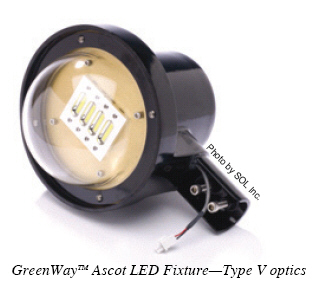 Outdoor lighting for trails and pathways is a great application of solar outdoor lighting. Solar LED light systems are a complete turnkey lighting systems designed for safety and security. Pathway/ Greenway systems are installed in many city settings meandering along river walks and hiking paths. Safety is an issue on trails and pathways and with the type of lighting provided by LED the human eye can distinguish better facial recognition and color determination. This lighting provides a clear white light in a concentrated elongated photometric pattern to maximize brightness and effectiveness. Peripheral (off-axis) vision is important for example, to enable pedestrians to detect a stranger approaching from the side, before the stranger can be seen or recognized in the direct (on-axis) field of view. High quality white light can provide significant benefits for pedestrians and drivers. Outdoor lighting for trails and pathways is a great application of solar outdoor lighting. Solar LED light systems are a complete turnkey lighting systems designed for safety and security. Pathway/ Greenway systems are installed in many city settings meandering along river walks and hiking paths. Safety is an issue on trails and pathways and with the type of lighting provided by LED the human eye can distinguish better facial recognition and color determination. This lighting provides a clear white light in a concentrated elongated photometric pattern to maximize brightness and effectiveness. Peripheral (off-axis) vision is important for example, to enable pedestrians to detect a stranger approaching from the side, before the stranger can be seen or recognized in the direct (on-axis) field of view. High quality white light can provide significant benefits for pedestrians and drivers.
One of the best qualities of a solar lighting system is it can be placed almost anywhere lighting is needed. With no connection to the grid for power solar lighting offers solutions in sensitive areas in parks and nature areas where lighting is needed but disturbing the surroundings is not feasible.
Power Draw of the Light
LED Benefits: Light Emitting Diodes (LED) are an economical choice in outdoor illumination. Due to their rapidly increasing efficacy, LED lighting is an appropriate choice for solar powered lighting. The choice of LEDs is critical to ensure that the light lasts a long time, does not quickly fade in intensity, and delivers a bright, crisp white light. SOL only uses high-brightness and high power LEDs in its products. High-Power LEDs are designed by LED manufacturers for use in higher lumen level applications. These LEDs are good choice for general illumination since High-Power LEDs are constructed with features to support a long life of high lumen output. These LEDs have a larger die size (the physical size of the LED) and more robust mechanical construction for better thermal performance. 5mm or signal-type LEDs are not appropriate for outdoor lighting.
-The use of LED lighting increases the lifecycle of bulb replacements which decreases maintenance transportation costs to the site for maintenance and replacements.
-LED technology has no dangerous mercury or lead and produces no other known disposable hazards.
-LEDs have longer life hours than HID lamps less costs for replacements over the life of the system.
-The total lifetime CO2 output is more in the induction bulb than it is in the Led bulb.
Panels: PV panels have typical lifecycle period exceeding 20 years and studies have found them operating many years beyond with minimal efficiency losses. The life cycle of solar outdoor lighting systems has vastly improved and have notable superiority over grid systems. To accurately right size a system to meet your needs, the components of the system need to be matched to the energy you use per night.
PV modules are very sensitive to shading. If a tree branch, building, signage or other items are shading from a distance, the shadow is diffuse or dispersed. These soft sources significantly reduce the amount of light reaching the cell(s) of a module. Thats why site evaluation is a key in determination of the proper amount of panels that will be required to provide the correct level of illumination.
The illustration in Figure 1 is a simple example of how much solar panel you would require to power a lighting system. The more light intensity and longer running time means bigger panel sizes to provide the necessary lighting.
Battery: Choosing the right battery for your application is very critical to ensuring that your solar system operates at peak efficiency, and lasts for as many hours of nighttime or cloudy weather. Materials for solar lighting systems are highly recyclable. Solar outdoor lighting uses batteries specifically designed for solar lighting applications. No car batteries here. Due to the battery technology, how battery charging and discharging is managed, batteries are expected to last between 4 and 6 years.
The illustration in Figure 2 shows that the longer you need to provide power in low sun light situations the more battery you need. The more batteries and the more panels mean more expense for the system thats why a right sized system is the key to cost effective outdoor lighting.
Lighting Supplier and Manufacture Experience
There are a number of reasons that solar outdoor lighting with LED technology makes sense.
Economic
-Distance from the electrical grid service is too far for connections,
-Cost of installation--economically feasible when no trenching, wiring and connection fees are needed,
-Eliminate power bill for long term stability locking in costs of electricity for the life of the project.
Performance
-No brown outs/black outs
-Distributed light, no single point of failure for stand-a-lone lighting systems
-Emergency lighting when disasters strike with no down time
Environmental
-No CO2 released
-Powered by renewable energy, free sunshine
-No disruption of environmentally sensitive areas with trenching and wiring
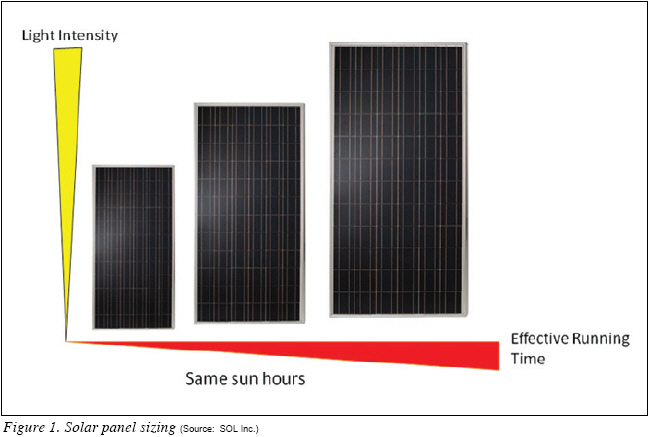
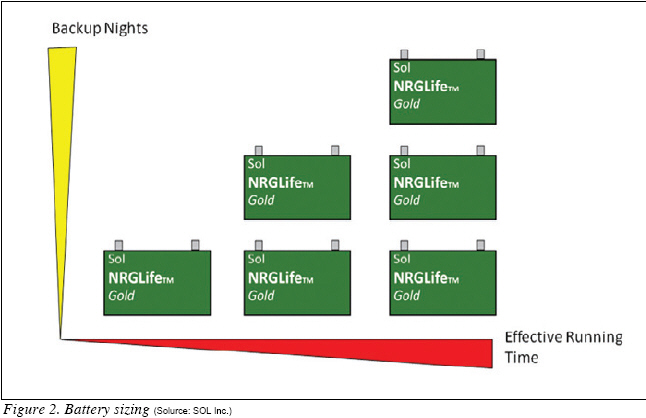
One issue stands above many, the company behind the manufacture and sizing of the systems. Solar lighting is not a new technology and if its properly sized, it is a technology that will provide outdoor lighting for a long time. Solar Panels have a life expectancy exceeding 20 years, LED lights are rated over 65,000 hours of use (over 10 years) and the components are made to withstand that period of time of operation. The right sizing of a system is carefully determined and then implemented by the manufacture of the outdoor lighting system.
SOL systems are backed by a FivePlusTM warranty that covers critical components including the PV module, hardware, light engine, luminaire, wire harness, electronics and battery well beyond the typical two year warranty.
Well, solar is great when done right. Right-sized systems backed up by a reputable company means satisfaction and reliability for years to come.
Not Super Sized, Not Value Sized, just Right Sized.
Audwin Cash, General Manager, SOL Inc. (www.solarlighting.com), is responsible for the design and introduction of new solar lighting systems for SOL, Americas leading manufacturer of commercial and industrial grade solar lighting systems. With over 10 years of experience developing efficient lighting controls and more recently efficient lighting powered by solar energy systems, Cashs expertise is blending environmental and economic lighting solutions. Cash is a member of the International Illuminating Engineering Society of North America, holds a BS in Computer Engineering from Georgia Institute of Technology, an MBA from Lehigh University and several US Patents.
REFERENCES
1) Number of nights autonomy means minimum number of nights the lights can work without receiving energy from the sun--the batteries provide a minimum of 5 nights of energy reserve.
For more information, please send your e-mails to pved@infothe.com.
¨Ï2011 www.interpv.net All rights reserved.
|



